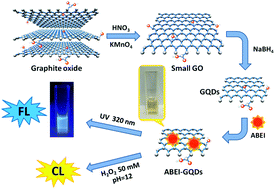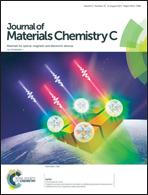Chemiluminescent and fluorescent dual-signal graphene quantum dots and their application in pesticide sensing arrays
Abstract
In this work, N-(aminobutyl)-N-(ethylisoluminol) (ABEI) functionalized graphene quantum dots (ABEI-GQDs) with excellent chemiluminescence (CL) and fluorescence (FL) properties were synthesized. Firstly, small 2-dimensional graphene oxide (GO) was prepared by exfoliating and crushing graphite oxide in the presence of HNO3 and KMnO4. Then the size of small 2-dimensional GO was further decreased by reduction with NaBH4 to form GQDs. After that, ABEI was immobilized to the surface of GQDs by simply stirring the mixture of GQDs and ABEI. The synthesized ABEI-GQDs demonstrated excellent CL properties when reacting with H2O2 and wavelength-tunable FL emission with increasing excitation wavelength. And the bright blue FL of ABEI-GQDs could be seen even with the naked eye. Based on their CL and FL properties, a pesticide-sensing array was developed for the differentiation of pesticides. It was found that the sensing strategy could distinguish five pesticides with different concentrations, including thiamethoxam, flubendiamide, dimethoate, dipterex and chlorpyrifos. Novel CL and FL dual-signal graphene quantum dots ABEI-GQDs were obtained for the first time, which may find more applications in bioassays and bioimaging in the future.



 Please wait while we load your content...
Please wait while we load your content...